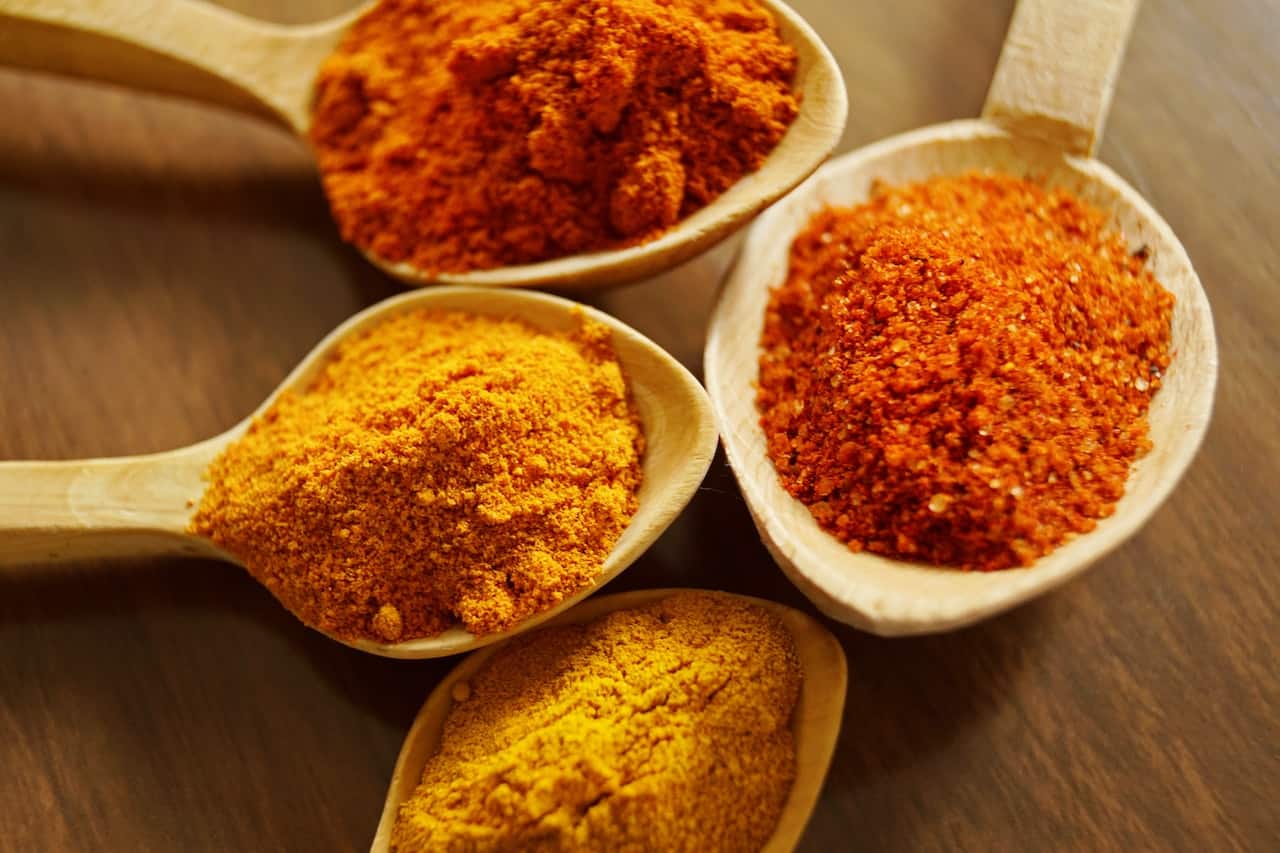Did you know that the spices you use in your favorite foods can aid in the control of your diabetes? Adhering to recommended prescriptions and controlling blood sugar levels are two ways to manage diabetes. While prescription drugs, regular exercise, and lifestyle modifications can all help manage diabetes, dietary adjustments can also stabilize blood glucose levels. Spices and herbs that are supposed to improve our general health may be abundant in Indian kitchens.
The essential oil concentration of spices from a plant’s bark, root, bud, or berry is extremely concentrated since they dried rather than fresh. Common spices have very potent antioxidant and antibacterial effects that are beneficial to general health. Certain spices have a reputation for effectively controlling blood sugar levels. We provide a list of fantastic spices you may regularly use to control your blood sugar.
With today’s poor diets and sedentary lifestyle, diabetes is a serious health concern. A nutritious diet is vital for diabetics, and any unexpected surge in blood sugar has the potential to be disastrous. Certain spices, in addition to nutrients, may aid in controlling blood sugar levels. If you haven’t packed your kitchen cabinet with any of these spices yet, you’d best get to the neighborhood grocery shop immediately. Here are some of the best spices for your diabetic problem.
What are Spices?
To improve food flavor, fragrance, and color, utilize spices, which are organic plant-based substances. Before usage, spices are frequently dried and processed into a fine powder from the seeds, roots, fruits, bark, or other plant components that they are typically made from. In addition to being often used in baking, cooking, and food preservation, spices can also be therapeutic. Cumin, Cinnamon, black pepper, coriander, ginger, turmeric, & nutmeg are a few popular spices. Spices can be used alone or in unique and savory mixes with other spices.
As South East Asia produces the bulk of the world’s spices, the spice trade has been a key contributor to global economic growth since the Middle Ages. A risky and protracted commercial route called the Silk Road was used from China to Europe. Spice shipments were expedited by sailing. Christopher Columbus decided to travel east instead of west to reach India more quickly, landing in North America. It is thought that the incorrect naming of Indigenous peoples as “Indians” resulted from this error in the continents.
Best Spices for Diabetics
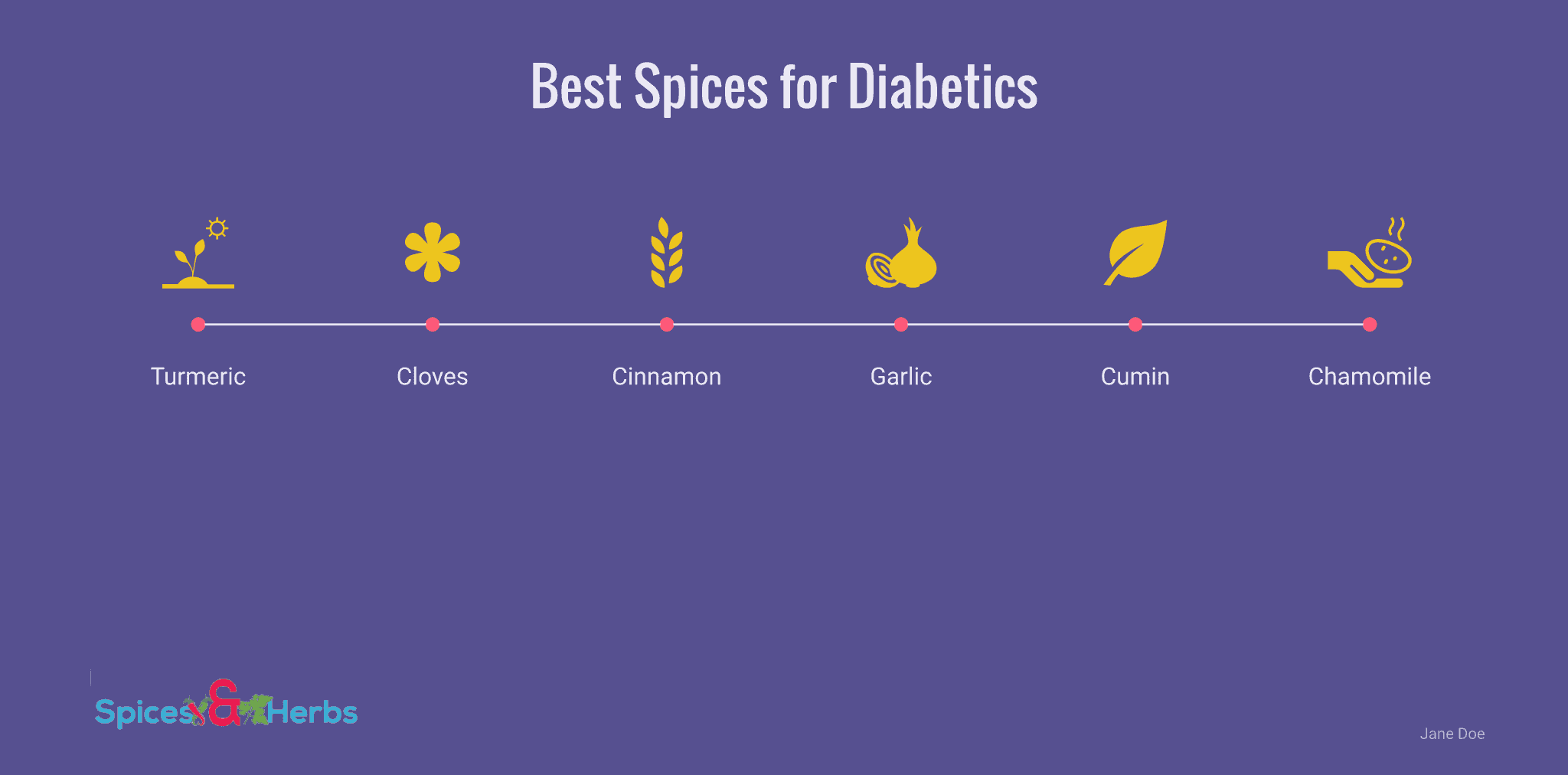
Diabetes management includes regulating one’s diet. As a result, adults with diabetes should receive a balanced diet. In diabetics, several herbs may increase insulin sensitivity, lower inflammation, and control blood sugar levels. However, although these spices may aid in managing diabetes, they shouldn’t be used in place of medical care.
Before taking any new spices or supplements, diabetics should always check with their doctor because they can interfere with their prescriptions. Before using spices and herbs to decrease blood sugar, talk to your doctor if you have any concerns about potential medication interactions or allergies. Here is our list of spices for diabetes complications.
🍶Turmeric
Turmeric has long been employed in Ayurveda for its therapeutic benefits. It is a fantastic spice for enhancing immunity and skin health because of its anti-inflammatory and antibacterial characteristics. Studies on its involvement in controlling diabetes have indicated that it may aid in controlling blood sugar levels.
According to research in the book Evidence-based Alternative and Complementary Medicine, the active ingredient in turmeric, known as curcumin, may help lower blood glucose levels, further decreasing difficulties associated with diabetes. Drinking turmeric milk and haldi doodh is the finest way to use turmeric to your advantage.
🍶Cloves
Both antibacterial and germicidal qualities may be found in cloves. Also, they enhance diabetes’ digestive, analgesic, and anti-inflammatory health. In addition to lowering blood sugar levels, cloves are known to increase insulin synthesis, which helps manage diabetes. A frequent sort of spice used in baking and cuisine is cloves. They have a potent, powerful flavor and perfume and are renowned for their health advantages.
Even though cloves cannot cure diabetes, they can be a beneficial supplement to a diabetic diet when used in moderation. Cloves have several advantages, including their ability to regulate blood sugar. Cloves include substances that can promote cellular glucose absorption and insulin sensitivity, which can help control blood sugar levels. This also contain many antioxidants, which can aid in lowering inflammation and enhancing general health.
Cloves should be used in moderation by diabetics, nevertheless, since an excessive amount may have a detrimental impact on their blood sugar levels. When deciding how much cloves or other spices should be part of their diet, it is advised that diabetics speak with their doctor or a qualified nutritionist.
🍶Cinnamon
Antioxidant cinnamon has been found to increase insulin sensitivity and lower fasting blood sugar levels. Cinnamon has been shown in the International Journal of Molecular Science research to enhance insulin sensitivity. To maintain your health, sip cinnamon tea. The spice cinnamon has been used in traditional medicine and culinary for many years. Cinnamon may benefit diabetics, according to some data. However, further studies are required to establish these conclusions firmly.
According to some research, cinnamon may enhance insulin sensitivity and reduce blood sugar levels in persons with type 2 diabetes. Cinnamon may have some benefits on blood sugar, but they don’t seem to be strong enough to displace current diabetic medications. Before using cinnamon in your diet, if you have diabetes, it’s vital to consult your doctor. Supplemental cinnamon may interfere with your drugs or negatively affect some people.
🍶Garlic
Research in the journal Functions and mechanisms found that diabetic rats that consumed garlic had higher blood insulin levels. Therefore be careful to include enough garlic in your diet each day. Garlic has been investigated for its possible advantages in treating diabetes, although the results are still preliminary. According to certain research, garlic may help diabetics with their insulin sensitivity, blood sugar levels, & cholesterol levels.
According to other research, garlic may help decrease blood sugar levels & enhance insulin sensitivity, although the findings are not universal.
Generally, garlic should not be used as the only treatment for diabetes, even if it may offer potential advantages for those with the disease. Individuals with diabetes should collaborate with their healthcare physician to create an all-encompassing treatment strategy that includes a balanced diet, regular exercise, and necessary medication.
🍶Cumin
Red lentils and brown rice pair well with cumin, a parsley-family spice. Cumin decreases cholesterol and blood sugar levels, so use it liberally. The more advanced glycation products, which are harmful to diabetes, are also well-affected by cumin.
🍶Chamomile
It is commonly known that chamomile tea has calming effects. This beverage has several health advantages, including reducing menstrual cramps, enhancing sleep, and curing colds. Research suggests that chamomile tea may also help older people with diabetes.
According to studies, chamomile also blocks enzymes related to diabetes-related problems, such as harm to the eyes, kidneys, or nerves. People with diabetes frequently use chamomile tea to reduce their blood sugar levels. The antioxidant quercetin in chamomile inhibits enzymes linked to diabetic reactions. After two months, type 2 diabetes individuals have demonstrated in several trials to have significantly lower blood sugar levels.
Herbs for Diabetics
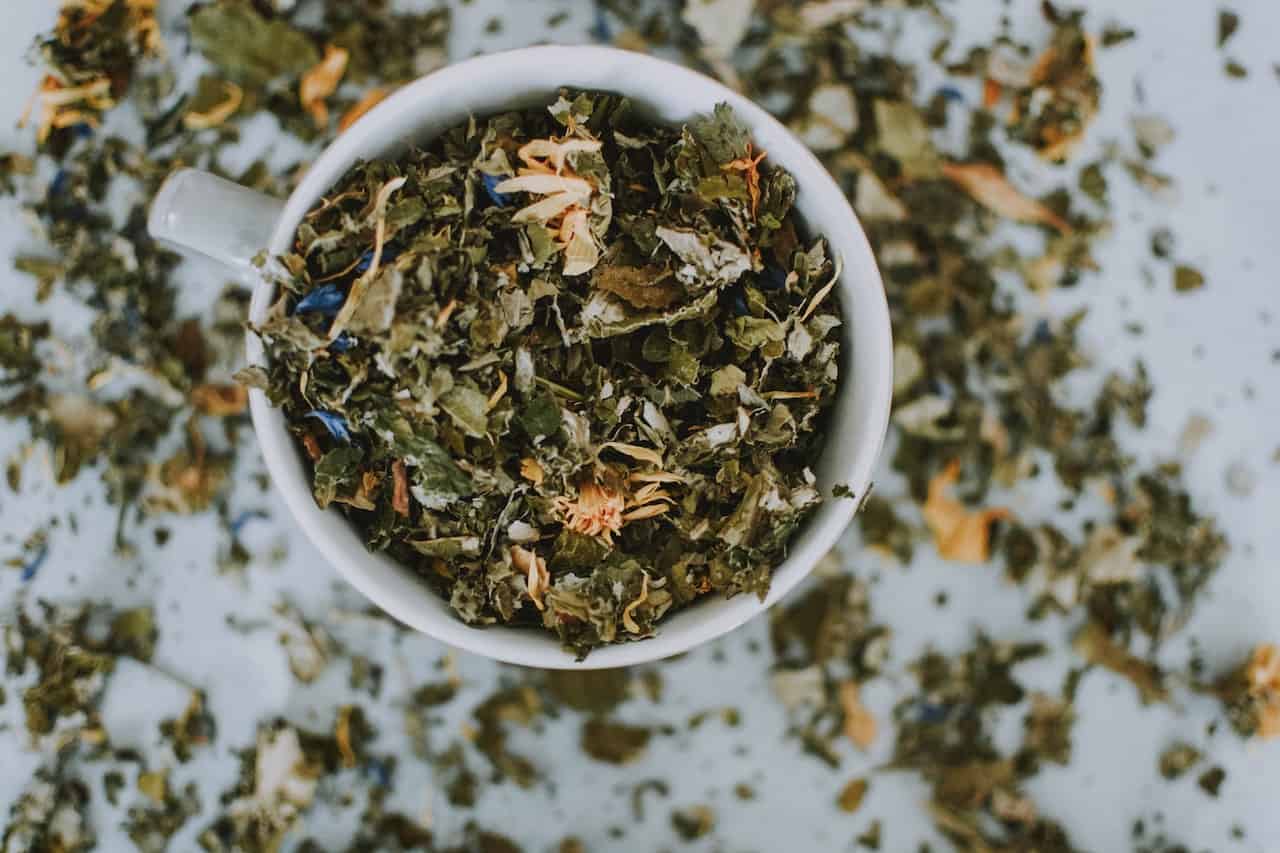
🌿Basil
Basil is a holy herb first grown in India, Asia, and Africa. By including basil in your diet, you may be able to control high blood sugar levels. The term “basil” comes from the ancient Greek “basilikhon,” which means “royal.” It has been demonstrated that basil extract can help cure diabetes in rats. Moreover, basil could be helpful in the long run for managing high blood sugar.
🌿Milk Thistle
Among the spices and herbs that treat diabetes is milk thistle, a member of the daisy & ragweed families. The Mediterranean area is where the plant is native. It is also known as the holy or mary thistle on occasion. Insulin resistance is a significant factor in type 2 diabetes. Milk thistle reduces insulin resistance. According to research, milk thistle can help with diabetes when used with conventional therapies.
🌿Curry Leaves
Curry leaves are notable for being high in fiber. Food fiber allows you to regulate your blood sugar level since it slows digestion but doesn’t metabolize rapidly. Beta-carotene, vitamin E, & carbazole alkaloids are just a few of the antioxidants found in curry leaves that may prevent diabetes and other chronic illnesses. Curry leaf contributes to blood sugar stabilization by increasing insulin activity.
🌿Gymnema
If you’re seeking for a herb to manage diabetes in senior people, Gymnema could be helpful. Gymnema Sylvestre is a plant that is native to India. The “sugar destroyer” is a substance that breaks down sugar before it enters the body. A 2013 evaluation found that gymnema is beneficial for treating type 1 and type 2 diabetes.
🌿Peppermint
The antioxidants found in peppermint help prevent cancer, diabetes, heart disease, and other diseases. And it enhances tea flavors greatly. Instead of buying it in tea bags, try to find it loose and fresh. Those with reflux should avoid peppermint since it relaxes the muscles that separate the stomach from the esophagus. For everyone else, it’s a delicious tea that promotes digestion.
🌿Sage
Sage often arrives in modest quantities due to its strong scent and earthy flavor. Despite this, it is brimming with chemicals and many vitamins for the aged. Sage has several health advantages, including enhanced cognitive function and a decreased cancer risk. Sage has a long history of usage as a diabetic treatment. This plant has been shown to rapidly and efficiently decrease blood sugar in both human and animal experiments.
🌿Lemon Balm
You may use lemon balm alone or in a product with other natural components. This herb is a perennial member of the mint family. Its leaves, which have a faint lemon scent, create medicines. Lemon balm may help diabetic seniors in lowering their sugar levels.
🌿Ginseng
Ginseng is one of the most often used herbal remedies, one of the most well-known worldwide, and a superb source of vitamins. Traditional Eastern medicines have employed ginseng roots to balance the body, reduce stress, and increase vitality for thousands of years. According to studies, ginseng extract can safely and effectively cure diabetes in the elderly. Research on American and Asian ginseng has found that type 2 diabetics had lower blood glucose levels.
🌿Rosemary
The plant has long been used in traditional herbal remedies, Ayurveda medicine, and culinary and fragrant arts. Researchers found that rosemary tea may reduce blood sugar levels, indicating that the plant may help diabetics with high blood sugar levels. According to research, the famous culinary herbs oregano & rosemary contain various advantageous chemicals, including those found in prescription anti-diabetic drugs.
🌿Lavender
There are several conventional and modern medical uses for lavender essential oil, including relieving diabetic symptoms. The study’s investigators discovered that lavender essential oil stabilized animal blood sugar levels and provided protection from oxidative stress, the root cause of difficulties in diabetic humans.
🌿Dill
With fish, eggs, or mushrooms, dill pairs well. Originating in the Middle East and southwest Russia, it entered European kitchens & apothecaries by Middle Ages despite its origins there. Its primary purpose at the time was to encourage women to produce more milk. It is now being researched as a diabetic treatment. To fight diabetes, dill has 70 distinct compounds, according to James Duke’s Ethnobotanical Database.
Diabetic Meal Plan
It’s important to use spices and condiments to bring out the tastes of your meal if you want to enjoy a type 2 diabetic diet. So be aware that certain options are far healthier than others before reaching for the ketchup & mayo. Learning to read nutritional info and precisely measure portions will also benefit you.
🍲Salad Dressing
Almost any of your favorite spices may be used in low-calorie salad dressings. Use this condiment as a marinade and dipping sauce for diabetes-friendly, lean foods like fish or chicken, or serve it with salads and sandwiches. To keep track of the amount of fat, salt, and sugar in the salad dressings you enjoy, just keep quantities under 2 tbsp and check nutrition labels.
🍲Vinegar
With no salt or fat, vinegar is a condiment with minimal calories and carbs. You may experiment to get the perfect taste for the foods you love eating by using the broad selection of vinegar readily accessible on grocery store shelves. Balsamic vinegar may help salad vegetables stand out, and vinegar combined with a little low-sodium soy sauce makes a tasty marinade. By combining them with spices and herbs, you may create your flavored vinegar.
🍲Garlic
With oregano, basil, & olive oil, garlic contributes to the distinct tastes of Italian and Mediterranean food. Onions, shallots, & chives, which are all members of the same plant family as garlic, are also healthy for your heart and can help prevent cancer. The highest anti-inflammatory effect among them is displayed by garlic, which inhibits the active cytokines in diabetes.
Garlic, however, has additional benefits. It decreases triglycerides, blood sugars, and C-reactive protein, a sign of inflammation. Almost every vegetable tastes good when topped with garlic & olive oil. I occasionally use dried garlic in my cooking, but it doesn’t have the same beneficial effects as fresh; raw, freshly sliced garlic appears to have the most potent effects.
🍲Horseradish
Horseradish is a common dipping sauce used with roast beef because of its powerful taste. Horseradish has just 2 g of carbohydrates per serving or around 1 tbsp. It may be included in low-fat marinades or beef, chicken, and fish sauces. While preparing meals for your diabetic diet, be aware that certain packaged horseradish-based condiments are rich in salt while others are high in fat. Be sure to check labels carefully.
🍲Mayonnaise
Mayo has a terrible rap, much like ketchup. Yet it may be a diabetes-friendly option if you pick one made with healthy fat (like olive oil) and ensure you only eat one serving or fewer as directed on the nutrition label. Always measure this condiment before spreading it to prevent overdosing.
🍲Relish
With just 5 g of carbs per 1 tbsp, sweet pickle relish just about qualifies as a free meal. Nonetheless, its distinctive flavor is a traditional condiment that goes great with hot dogs, tuna fish sandwiches, and a variety of other foods. Since the flavor is so fantastic, adhering to the serving size restriction should be simple so that you may put this in your diabetes plan.
🍲Mustard
Both traditional yellow mustard and the spice-rich stone-ground varieties of this condiment are great toppings for burgers and sandwiches. For some meats, mustard may enhance flavor. It is typically included in the “free” category for people with type 2 diabetes, consisting of foods with less than Twenty calories & a maximum of 5 grams of carbohydrates in each serving. It is also low in fat and carbohydrates. Just limit yourself to 1 tbsp or one serving.
Benefits of a Good Diet for Diabetics
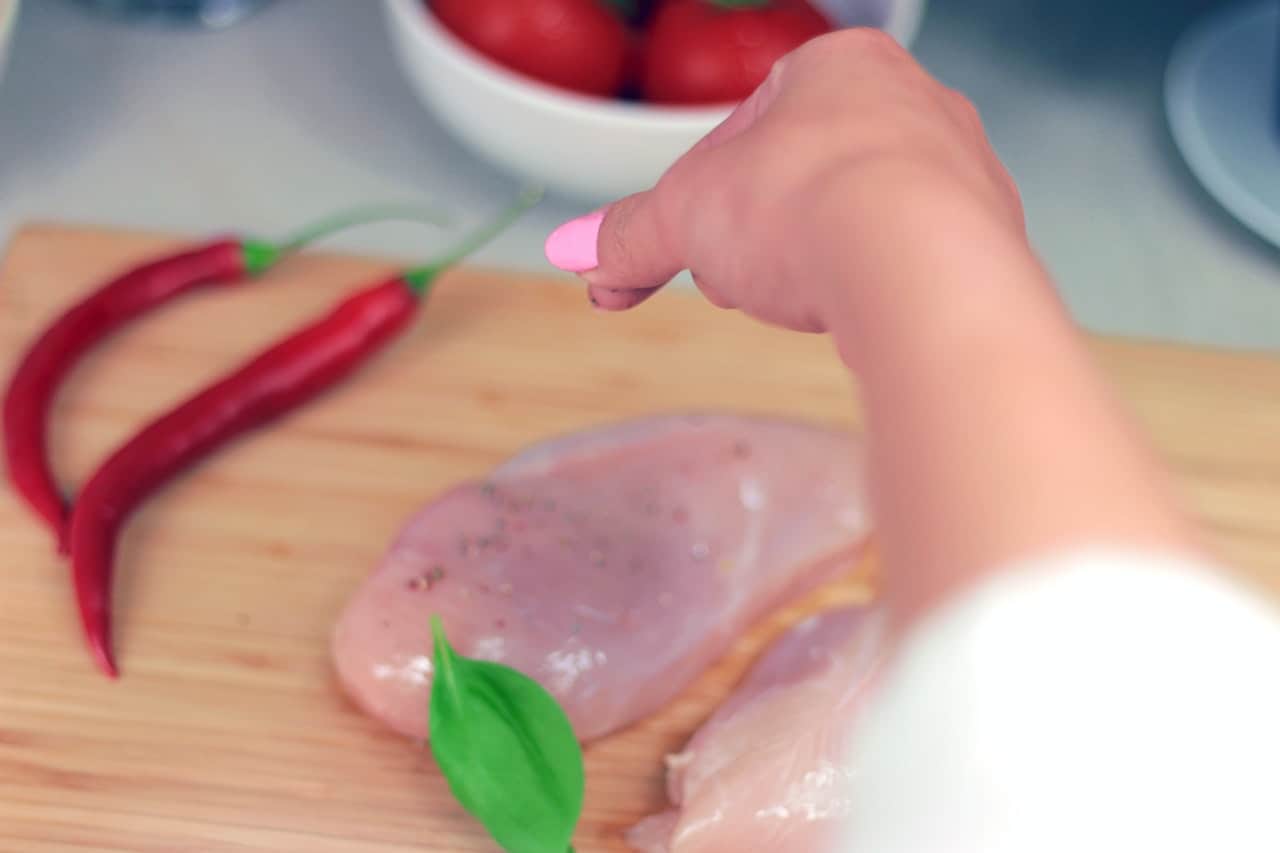
Blood sugar control is only one aspect of diabetes care. The appropriate upkeep of insulin, blood sugar levels, and the other moving elements of this disease require several other variables. Hence, maintaining a healthy and long life requires combining a good diet and regular exercise with frequent insulin injections & glucose meter readings.
In addition to controlling diabetes, everyone should follow a nutritious diet and regular season meals with some advantageous (and tasty) herbs, spices, and seasonings. We all know that not everyone enjoys cooking. Still, fortunately, herbal supplements may help counteract the consequences of a bad diet and ensure you continue to ingest those anti-inflammatory and antioxidant plants daily.
Reduced risk for cardiovascular disease, enhanced cellular health, and development, decreased pain and inflammation, improved cognitive function, and higher energy are additional advantages of a healthy diet for those with diabetes.
Cooking Tips with Spices
Spices begin to lose taste when ground, which is something to bear in mind when using them in cooking. So, if feasible, it’s advisable to grind your spices before using them rather than utilizing previously ground spices. For this, a mortar and pestle or coffee grinder can be used. If you decide to utilize a coffee grinder, you might want to use separate ones for coffee beans and spices to avoid unintentionally tainting your morning brew.
🥣Fresh Spices
Although spices don’t truly go bad or rot, they do gradually lose their flavor. The greatest practice is to utilize spices within a specific amount of time because they are typically introduced specifically to add flavor. If it’s impossible to ground your spices, use the freshest spices you can find. Generally, whole dried spices can survive four years, and crushed spices up to three years when properly preserved.
🥣Storing
Keeping spices in a cold, dry environment extends their shelf life. Hence, putting spice jars next to any stove can drastically shorten their usable life. Your spices retain their flavor longer if you store them in a transparent container or an enclosed spice rack.
Reasons for Adding Spices for Diabetics
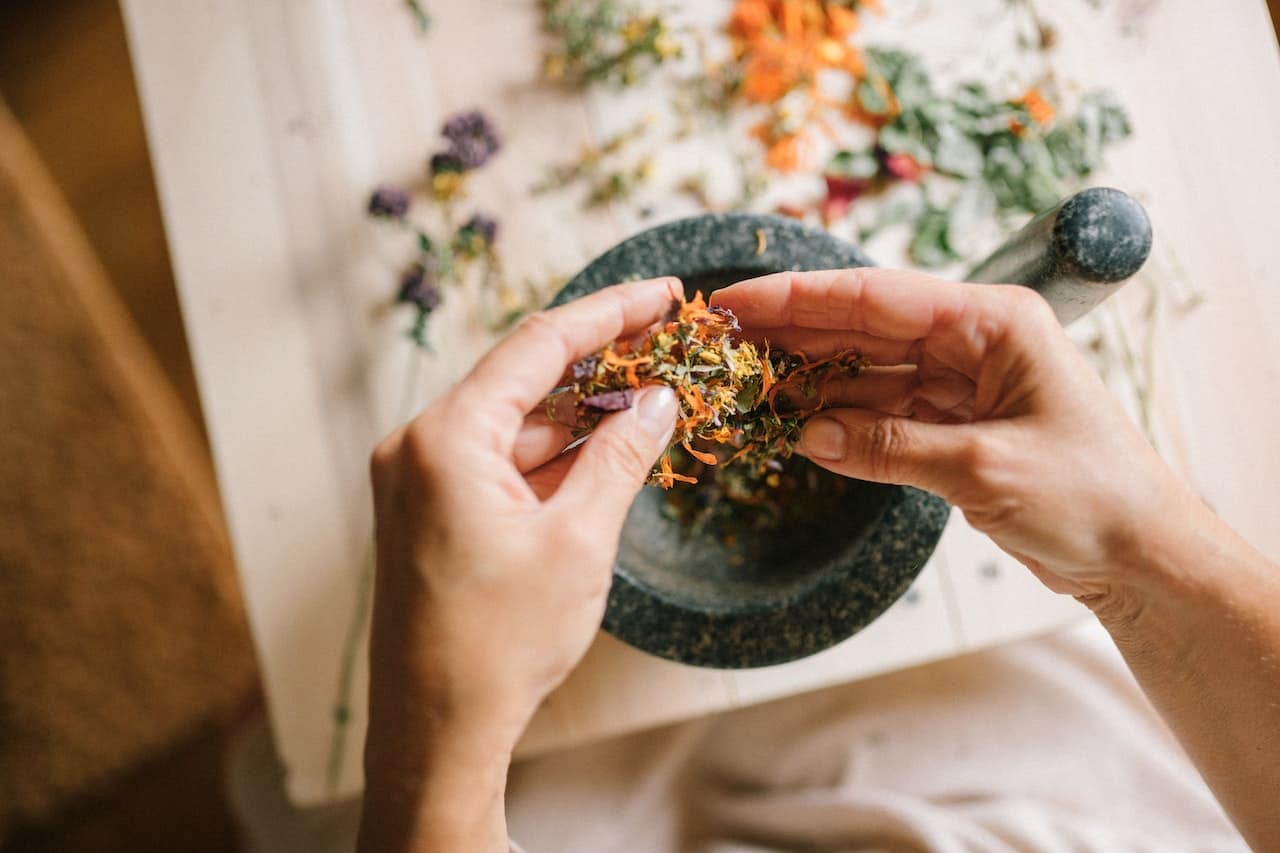
Many factors make spices a fantastic complement to the diet of someone with diabetes:
👉Increasing Flavor
Food can benefit from the taste and diversity that spices bring, making eating more pleasurable. Less temptation to season food with salt, sugar, and fat may improve blood sugar management.
👉Lower the Glycemic Index
Cinnamon is one spice that can help decrease a food’s glycemic index, which can help control blood sugar levels after a meal. Those with diabetes who must control their blood sugar levels may find this to be of particular use.
👉Inflammation Reduction
Those with diabetes may benefit from the anti-inflammatory qualities of several spices, including ginger and turmeric. Diabetes is one of several illnesses for which inflammation would be a risk factor.
It’s crucial to remember that some spice mixtures or sauces could have extra salt or sugar, which should be avoided when suffering from diabetes. A certified dietitian or your doctor should be consulted before adding any new spices to your diet if you are on diabetic medication since they may interfere with your medication.
Frequently Asked Questions
Can herbs and spices control blood sugar levels?
It has been demonstrated that several spices, including cinnamon, turmeric, & ginger, have blood sugar-regulating qualities. It’s crucial to remember that spices should be used as a supplement to a generally healthy diet and way of life because they cannot manage diabetes on their own.
Can diabetics eat spices?
Yes, in general, spices are safe for diabetics. Since they contain few carbs, you may flavor meals with them without raising blood sugar levels.
What spices should diabetics avoid using?
There are no particular spices that people with diabetes should completely avoid; however, some spices may be rich in salt and should only be used seldom. It’s crucial to read food labels and, if feasible, pick low-sodium products.
How can people with diabetes include spices in their diet?
By utilizing spices to flavor food rather than salt or sugar, diabetics may include spices in their diet. Spices may be used to season vegetables, meats, and dishes like soups, stews, and stir-fries. Herbal teas may also be a fantastic way to include spices in your diet.
Are there any dangers to eating too many spices?
Large doses of some spices, including cinnamon, can have negative consequences on the body, such as liver damage and low blood sugar. Before utilizing any spices as a therapy for diabetes, it’s crucial to do so in moderation and after consulting a healthcare provider.
Can eating onions help diabetics?
People with diabetes are frequently urged to eat more low-carbohydrate meals. Since they metabolize quickly, carbohydrates can cause swings in blood sugar levels. 5. Onion has a glycemic index under 55, making it a great choice for those with diabetes.
Final Thoughts
People with diabetes may find that adding spices to their diets is beneficial. Certain spices have been demonstrated to provide potential health advantages for persons with diabetes and add taste and diversity to meals. While spices may have health advantages, it’s crucial to remember that they shouldn’t be used as the only method of treating diabetes. Diabetes must be managed with a healthy diet, regular exercise, and prescription medicines. Nevertheless, before using any nutritional or herbal supplements for diabetes, please speak with your doctor. Do you want to know the best herbs for memory and focus? Click Here!

